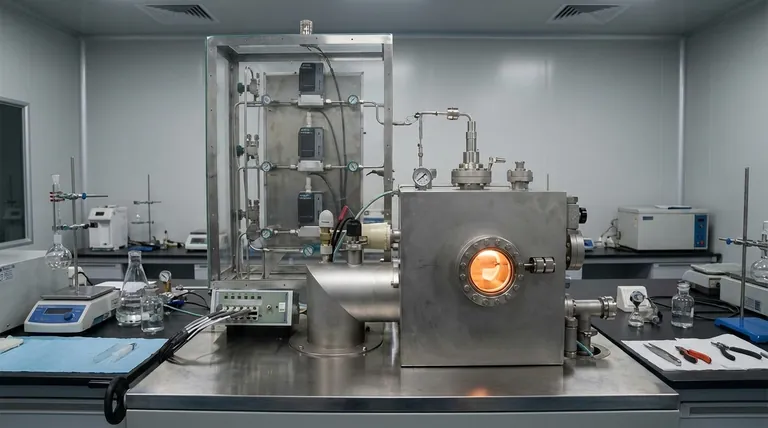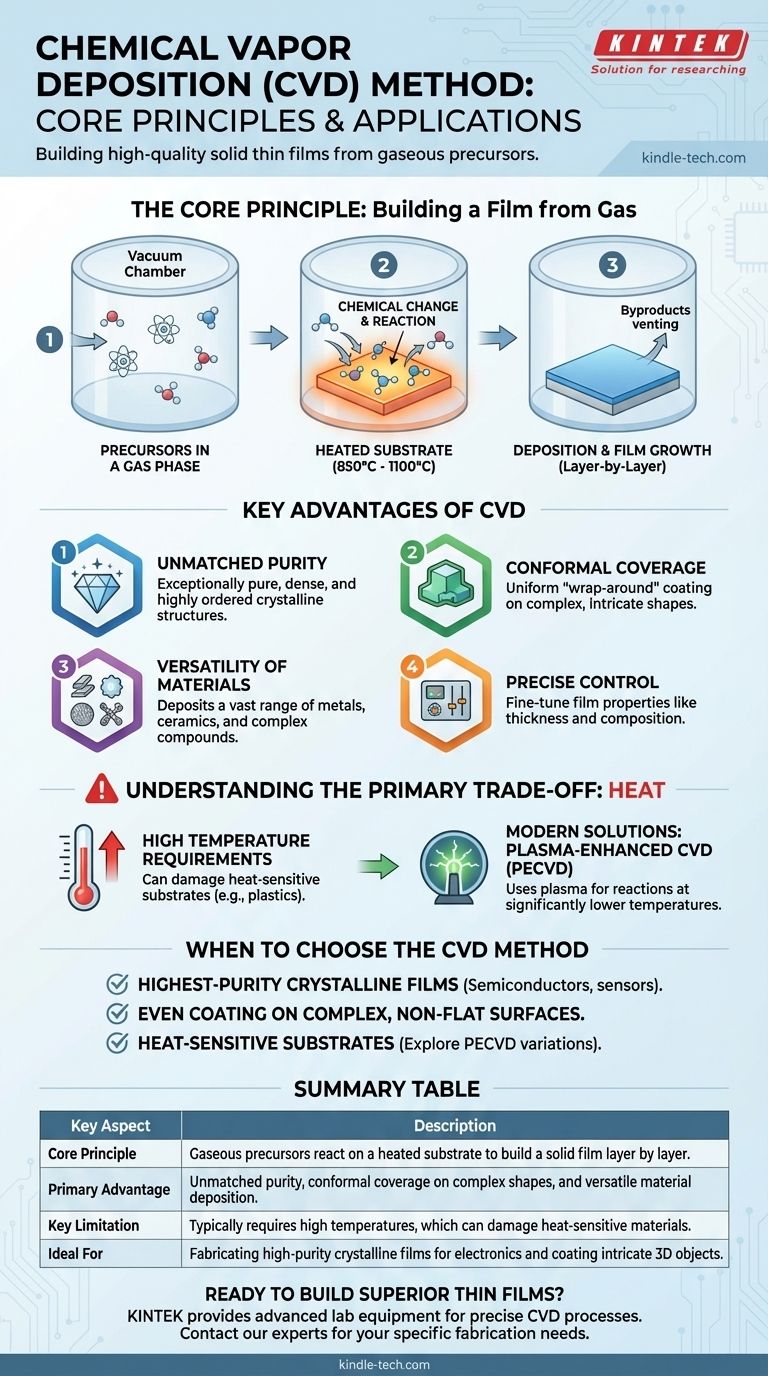In essence, the Chemical Vapor Deposition (CVD) method works by introducing reactive gases into a chamber where they chemically react on a heated surface, known as a substrate. This reaction causes a solid material to form and deposit onto the substrate, building a high-quality, thin film layer by layer. It is a bottom-up fabrication process used to create solid materials with exceptional purity and structural control.
The core function of CVD is not merely to coat a surface, but to precisely construct a new solid film directly on it from a gaseous state. This allows for the creation of materials with properties that are often impossible to achieve through other means.

The Core Principle: Building a Film from Gas
CVD is a highly controlled process that transforms gaseous chemicals, called precursors, into a solid, high-performance coating. The entire process hinges on three fundamental characteristics.
1. Precursors in a Gas Phase
The process begins by introducing specific precursor gases into a vacuum chamber. These gases are carefully chosen because they contain the atomic elements needed for the final film.
2. A Chemical Change on a Hot Surface
The substrate—the object to be coated—is heated to a high temperature, typically between 850°C and 1100°C. This intense heat provides the necessary energy to trigger a chemical reaction or cause the precursor gases to decompose when they come into contact with the hot surface.
3. Deposition and Film Growth
As the gases react on the substrate, they deposit a solid material. This material builds up atom by atom or molecule by molecule, forming a thin, dense, and uniform film. Unreacted gases and chemical byproducts are then vented from the chamber, leaving only the pure film behind.
Key Advantages of the CVD Method
The unique nature of the CVD process provides several significant benefits that make it a leading choice for advanced manufacturing, particularly in electronics and materials science.
Unmatched Purity and Crystalline Quality
Because the film is built from a purified gas source in a controlled environment, the resulting layer is exceptionally pure and dense. This allows for the growth of highly ordered crystalline structures, which is critical for applications like semiconductors and high-performance graphene.
Excellent Conformal Coverage
Since the precursor is a gas, it can flow around and make contact with every part of a complex, three-dimensional object. This results in a "wrap-around" effect, producing an even and uniform coating over intricate shapes where line-of-sight methods would fail.
Versatility of Materials
CVD is not limited to one type of material. By changing the precursor gases, it is possible to deposit a vast range of films, including metals, ceramics, alloys, and other complex compounds.
Precise Control Over Film Properties
Technicians can precisely control the final film's characteristics—such as its thickness, chemical composition, and crystal structure—by carefully adjusting process parameters like temperature, pressure, and the flow rate of the gases.
Understanding the Primary Trade-off: Heat
Despite its powerful advantages, the CVD method has one major limitation that must be carefully considered.
High Temperature Requirements
Traditional CVD requires extremely high temperatures to activate the chemical reactions. Many potential substrate materials, such as plastics or certain electronic components, cannot withstand this heat and would be damaged or destroyed during the process.
Modern Solutions to the Heat Problem
To overcome this limitation, specialized variations of CVD have been developed. Techniques like Plasma-Enhanced CVD (PECVD) use an electrical field to create a plasma, which provides the energy for the reaction to occur at much lower temperatures. This allows the benefits of CVD to be applied to heat-sensitive materials.
When to Choose the CVD Method
Selecting the right deposition technique depends entirely on your project's specific goals and constraints.
- If your primary focus is producing the highest-purity crystalline films (e.g., for semiconductors or sensors): CVD is the leading industry standard due to its precise, bottom-up control over material quality.
- If your primary focus is evenly coating complex, non-flat surfaces: CVD's gas-phase nature provides superior conformal coverage that many other methods cannot match.
- If your primary focus is working with heat-sensitive substrates: Traditional high-temperature CVD is unsuitable, and you must explore lower-temperature variations like PECVD.
Ultimately, understanding these core principles allows you to leverage CVD not just as a coating technique, but as a powerful tool for advanced material fabrication.
Summary Table:
| Key Aspect | Description |
|---|---|
| Core Principle | Gaseous precursors react on a heated substrate to build a solid film layer by layer. |
| Primary Advantage | Unmatched purity, conformal coverage on complex shapes, and versatile material deposition. |
| Key Limitation | Typically requires high temperatures, which can damage heat-sensitive materials. |
| Ideal For | Fabricating high-purity crystalline films for electronics and coating intricate 3D objects. |
Ready to build superior thin films for your laboratory projects?
KINTEK specializes in providing the advanced lab equipment and consumables needed for precise Chemical Vapor Deposition processes. Whether you are developing next-generation semiconductors, high-performance sensors, or novel materials, our solutions ensure the purity, conformity, and control that CVD is renowned for.
Contact our experts today to discuss how we can support your specific fabrication needs and help you achieve exceptional material quality.
Visual Guide

Related Products
- Inclined Rotary Plasma Enhanced Chemical Vapor Deposition PECVD Equipment Tube Furnace Machine
- HFCVD Machine System Equipment for Drawing Die Nano-Diamond Coating
- 915MHz MPCVD Diamond Machine Microwave Plasma Chemical Vapor Deposition System Reactor
- Vacuum Hot Press Furnace Machine for Lamination and Heating
- 1200℃ Split Tube Furnace with Quartz Tube Laboratory Tubular Furnace
People Also Ask
- What is PECVD used for? Achieve Low-Temperature, High-Performance Thin Films
- What is PECVD silicon deposition? Achieve Low-Temperature, High-Quality Thin Films
- What materials are deposited in PECVD? Discover the Versatile Thin-Film Materials for Your Application
- How does plasma enhanced CVD work? Achieve Low-Temperature, High-Quality Thin Film Deposition
- What is the difference between PECVD and CVD? Unlock the Right Thin-Film Deposition Method



















